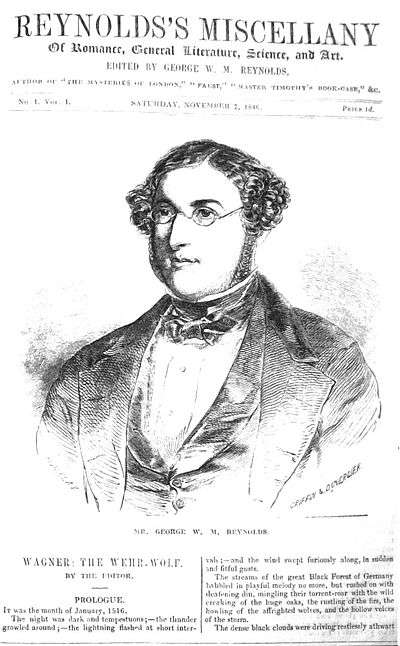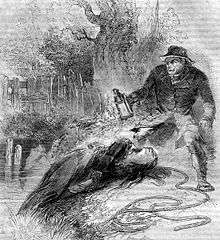George W. M. Reynolds

George William MacArthur Reynolds (23 July 1814 – 19 June 1879) was a British author and journalist.
He was born in Sandwich, Kent, the son of Captain Sir George Reynolds, a flag officer of the Royal Navy. Reynolds was educated first at Dr. Nance's school in Ashford, Kent, and then attended the Royal Military College, Sandhurst. He was intended for a career in the British Army, but on the death of his parents during 1829 and his subsequent inheritance, he decided to quit the military and devote himself instead to literary pursuits. He left Sandhurst on 13 September 1830 and for the next few years he traveled a great deal, particularly in France, and became a naturalised French citizen.[1] He began residence in Paris in 1834, where he started a daily English newspaper. The venture failed, and Reynolds returned bankrupt to England in 1836.
Reynolds served as editor of The Teetotaler (a weekly journal advocating teetotalism) beginning in 1840.[2]
Novels
Reynolds was a prolific writer of popular fiction starting from The Youthful Imposter, published in 1835. Virtually forgotten now, during his lifetime he was more read than Dickens or Thackeray; in his obituary, the trade magazine The Bookseller called Reynolds "the most popular writer of our times" ("Obituary" 600). His best-known work was the long-running serial The Mysteries of London (1844), which borrowed liberally in concept from Eugène Sue's Les Mystères de Paris (The Mysteries of Paris). It sold 40,000 copies a week in penny instalments and more than a million copies cumulatively before it was issued in bound volumes, enjoying an international circulation in French, German, Italian, and Spanish translations. Although it was outlawed by the authorities, the German version achieved the status of a cult favourite on the Russian black market.
The Mysteries of London and its even lengthier sequel, The Mysteries of the Court of London, are considered to be among the seminal works of the Victorian "urban mysteries" genre, a style of sensational fiction which adapted elements of Gothic novels - with their haunted castles, innocent noble damsels in distress and nefarious villains - to produce stories which instead emphasized the poverty, crime, and violence of a great metropolis, complete with detailed and often sympathetic descriptions of the lives of lower-class lawbreakers and extensive glossaries of thieves' cant, all interwoven with a frank sexuality not usually found in popular fiction of the time.

The Mysteries of London, like most of Reynolds' works, was published first as a weekly penny dreadful or 'Penny Blood,' illustrated with lurid engravings and circulating mainly among readers of limited means and education. Although Reynolds was unusual in his religious skepticism (one of the main characters in The Mysteries of London was a clergyman turned libertine) and political radicalism, his tales were intended for his mostly middle- and lower-class readers; they featured "hump-backed dwarves, harridans and grave-robbers [who] groped past against a background of workhouses, jails, execution yards, thieves' kitchens and cemeteries. His readers could depend on him to bring in the theme of maiden virtue rudely strumpeted as often as possible."
Reynolds' Wagner, the Wehr-Wolf was a gothic novel which described how the title character became a werewolf after making a pact with the devil.[3] Wagner, the Wehr-Wolf was republished in 1975 by Dover Books with an introduction and bibliography of Reynolds by E. F. Bleiler.[3]
Reynold's novels remained in print on both sides of the Atlantic longer than those of many of his contemporaries. An 1875 edition of Reynolds's Ciprina, published in Philadelphia, lists 40 novels including Mysteries of London under the heading "George W. M. Reynolds' Great Works," priced between 50 cents and $1.00. The Mysteries of the Court of London, translated into Marathi as well as Urdu, remained a best-seller in India well into the twentieth century. The Marathi translation was done by K.B. Mande in the early 20th century and was titled "The secret deeds of the elites of London". It was very popular in the Marathi-speaking area, as is evident by numerous references to the text in early 20th-century Marathi literature.
Chartism
Reynolds was also a major figure in the Chartist movement. In 1846, he founded two magazines, Reynolds' Miscellany (RM) and The London Journal (LJ). In 1849, he founded "Reynolds's Political Instructor," which in May 1850 became Reynolds Weekly Newspaper, the leading radical newspaper of the post-Chartist era. It long survived him, ending publication in 1967 as the Sunday Citizen.
In 1854, he relocated to Herne Bay in Kent, where he became one of the town's Improvement Commissioners. Reynolds was an advocate of British Republicanism; much of his journalism, especially during the 1870s, "promoted a levelling agenda against traditional social hierarchies and accentuated the difficulties of the British throne".[4]
Bibliography
- The Youthful Imposter (1835).
- Pickwick Abroad; or, the Tour in France (1837-8).
- Alfred; or, the Adventures of a French Gentleman (1838).
- Grace Darling; or, the Heroine of the Ferne Islands (1839).
- Robert Macaire in England (alt title: The French Bandit in London) (1839).
- The Modern Literature of France (1839) Non-fiction.
- The Steam Packet: a Tale of the River and Ocean (1840).
- Master Timothy's Bookcase (1842).
- The Mysteries of London (1844–48) - weekly serial.
- Faust: A Romance of the Secret Tribunals (1847) (LJ).
- Wagner, the Wehr-Wolf (1846-7) (RM).
- The Days of Hogarth; or, the Mysteries of Old London (1847–48) (RM).
- The Coral Island, or the Hereditary Curse (RM) (later widely pirated with the title The Mysteries of the Court of Naples) (1848).
- The Mysteries of the Court of London (1848–56) - weekly serial.
- The Pixy; or, the Unbaptized Child (1848) (RM).
- The Bronze Statue; or, the Virgin's Kiss (1849–50) (RM).
- The Seamstress; a Domestic Tale (alt title: The White Slaves of England) (1851) (RM).
- Pope Joan, the Female Pontiff (1851) (RM).
- Kenneth, a Tale of the Highlands (1851-2) (RM).
- The Necromancer (1851-2) (RM).
- Mary Price; or the Memoirs of a Servant Girl (1852).
- The Massacre of Glencoe, a Historical Tale (1852-3) (RM).
- The Soldier's Wife (alt title: The Cat o' Nine Tails)(1852-3).
- The Ryehouse Plot; or, Ruth, the Conspirator's Daughter (1853-4) (RM).
- Joseph Wilmot; or, the Memoirs of a Manservant (1853-4).
- Rosa Lambert; or, the Memoirs of an Unfortunate Woman (alt title: The Memoirs of a Clergyman's Daughter)(1854-5).
- Agnes; or, Beauty and Pleasure (1854-5).
- Ellen Percy; or, the Memoirs of an Actress (1854-5).
- May Middleton; or, the History of a Fortune (1854-5) (RM).
- Loves of the Harem (1855).
- Omar, a Tale of the War (1855-6) (RM).
- Leila; or, the Star of Mingrelia (1856) (RM).
- The Empress Eugenie's Boudoir (1856).
- Margaret; or, the Discarded Queen (1856-7) (RM).
- The Young Duchess (sequel to Ellen Percy) (1856-7).
- Canonbury House; or, the Queen's Prophecy (1857-8) (RM).
- Mary, Queen of Scots (1858-9).
Further reading, etc.
- Archive.org's snapshot of the Literature and Place George W.M. Reynolds arcitle at the Wayback Machine (archived 28 September 2007).
- The Literary Encyclopedia G. W. M. Reynolds.
- Mapping History's Nightmares: A Geography of Victorian Gothic Fiction:27-33; Robert Mighall.
- The Library 1973 s5-XXVIII(4):319-326; George W. M. Reynolds: A Bibliography.
- G.W.M. Reynolds - Nineteenth Century Fiction, Politics, and the Press, ed. by Anne Humpherys and Louis James, Ashgate 2008.
- BBC Radio 3 Sunday Feature: "The Other Dickens" (45-minute audio documentary).
- In Ian Hall's 2015 Novel series The Penny Dreadful Adventures, the author inserts his main character into Victorian London to edit The Mysteries of London for Reynolds.
References
- ↑ "The Other Dickens", aired on BBC Radio 3, 1 July 2012
- ↑ Reynolds, George W. M., ed. (1840-07-25). "The Teetotaler". I (5). London: United Temperance Association. Retrieved 2011-12-18.
DEVOTED TO TEMPERANCE, LITERATURE, AND SCIENCE. EDITED BY GEORGE W. M. REYNOLDS
- 1 2 B. F. Fisher, B. F., "Wagner, The Wehr-Wulf". in: Frank N. Magill, ed. Survey of Modern Fantasy Literature, Vol 4. Englewood Cliffs, NJ: Salem Press, Inc., 1983. ISBN 0-89356-450-8 (pp. 2049-2053) .
- ↑ Andrzej Olechnowicz, The Monarchy and the British Nation, 1780 to the Present. Cambridge University Press, 2007. ISBN 0521844614, (p. 190).
External links
Books available online
| Wikisource has the text of the 1885–1900 Dictionary of National Biography's article about Reynolds, George William MacArthur. |
All titles marked (RM) and (LJ) above are available online at the British Periodicals website.
- Works by George W. M. Reynolds at Project Gutenberg
- Works by or about George W. M. Reynolds at Internet Archive
- Works by George W. M. Reynolds at LibriVox (public domain audiobooks)

- Alfred de Rosann; or, Adventures of a French Gentleman at Internet Archive.
- Ellen Percy: or, The memoirs of an actress, vol. II at the University of Michigan.
- The Empress Eugenie's Boudoir at Internet Archive.
- The French Self-Instructor at Internet Archive.
- Mary Price; or, The memoirs of a servant-maid at the University of Michigan.
- The Mysteries of London at victorianlondon.org.
The complete set of the two series in four volumes of "The Mysteries of London" in epub format is available at mobileread.com
Mysteries of the Court of London (Dicks edition in 8 volumes; 4 series, 2 volumes each) online at books.google.com:
- First Series, vol. I,
- First Series, vol. II,
- Second Series, vol. I,
- Second Series, vol. II (not available),
- Third series, vol. I,
- Third series, vol. II,
- Fourth series, vol. I,
- Fourth series, vol. II.
The Mysteries of the Court of London (privately printed edition of the "Mysteries" in 20 volumes (by a so-called "Oxford Society") was entitled "The Works of George W. M. Reynolds", online at www.archive.org (only 7 volumes of this edition):
The complete set of the four series in eight volumes of "The Mysteries of the Court of London" in epub format is available at mobileread.com
- The Parricide ; or, The Youth's Career of Crime, a slightly modified re-printing of The Youthful Imposter at Internet Archive.
- Pickwick Abroad at Internet Archive.
- Robert Macaire; or, The French Bandit in England at the University of Michigan.
- Wagner the Wehr-Wolf at Project Gutenberg.
- The Young Duchess; or, Memoirs of a Lady of Quality at the University of Michigan.
Reviews and literary criticism
- Frank Jay's discussions of Reynolds from Spare Moments at the Wayback Machine (archived 26 October 2009) Published between 1918 and 1921. Posted by Justin Gilbert at GeoCities.
- "G. W. M. Reynolds" by E.F. Bleiler, in Bleiler (ed) Supernatural Fiction Writers: Fantasy and Horror NY: Charles Scribner's Sons, 1985, 205-11. Primarily an examination of Reynolds novels Faust, The Necromancer and Wagner, the Wehr-wolf.
- E.F. Bleiler. "Introduction." "Bibliography." in G. M. W. Reynolds, Wagner, the Wehr-wolf. NY: Dover, 1975. (The only full modern statement on Reynolds, with much new information. The bibliography is the only disentanglement of Reynolds' exceedingly complex publications).
- G. W. M. Reynolds: Nineteenth-Century Fiction, Politics, and the Press, edited by Anne Humpherys and Louis James, Ashgate, 2008
- Andrew King, The London Journal 1845-1883: Periodicals, Production and Gender, Ashgate, 2004
- Dick Collins. "Introduction." George W.M. Reynolds, Wagner The Werewolf Hertforshire: Wordsworth Editions, 2006, ix-xvii.
| Media offices | ||
|---|---|---|
| Preceded by New position |
Editor of Reynold's News 1850–1879 |
Succeeded by Edward Reynolds |